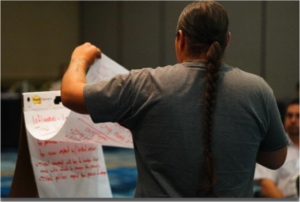Mobilizing Men and Boys to Prevent Gender-Based Violence

Mobilizing Men and Boys is an important approach toward preventing domestic violence and sexual assault. In the 2016 STOP SV: A Technical Package, the CDC described this approach as “an opportunity to encourage men and boys to be allies in preventing sexual and relationship violence by demonstrating their role in preventing violence….”
Last week the Office on Violence Against Women released several reports about men’s roles in efforts to prevent sexual violence and domestic violence. Native Men’s Gathering: Experiences That Shape Behaviors and Beliefs about Violence Against Women provides a summary of this first gathering of its kind where Native Men shared what they have learned in activating men to engage in vigorous roles that foster nonviolence and hold other men accountable for change, responsibility and forgiveness. The participants highlighted the importance of tradition and cultural practices for this work in tribal communities.
Where We’ve Been, Where We’re Going: Mobilizing Men and Boys to Prevent Gender-Based Violence summarizes the findings from a roundtable discussion held in August 2016 with a diverse group of men and women who are national and local experts and leaders including those who work to engage men and boys, work with y0uth generally, and representatives from trafficking, domestic violence, and sexual assault organizations.
The roundtable participants made several recommendations:
- Establish a national collaborative for mobilizing boys and men. Currently, many entities work to engage men and boys, but there is no centralized source for setting standards, gathering resources, promoting training and research, and advancing advocacy.
- Practice accountability inside the field and meet boys and men where they are. The participants recommended renewed emphasis on accountability toward each other and those impacted by violence.
- Address gaps in the sphere of influence and conduct research. Bring more attention to groups that are currently under-involved (such as corporate executives, clergy, and the entertainment industry), create an interagency task force to more intentionally coordinate and collaborate federal efforts to mobilize men, and support research and evidence-based practices.
- Promote a positive approach in the field of mobilizing men and boys. To facilitate the adoption of a new, healthier mindset about gender-based violence, participants recommended several approaches: create working definitions of healthy masculinity across multiple communities; leverage the power of positive narratives and storytelling; and use hip hop and pop culture as tools for helping youth to connect with and understand more positive, healthier forms of masculinity.
These discussions are important efforts to support the development of efforts to empower men and boys to prevent domestic violence and sexual assault.
